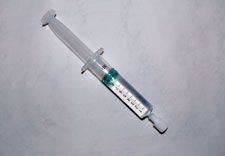Container Closures: Leaving Nothing to Chance
As closure integrity testing moves from a probabilistic to a deterministic basis, designs are promoting improved control and reduced operator contact.
Redbrick Media/Shutterstock.com

Few things could be more taken for granted than container closures--the caps and stoppers that seal biopharmaceutical products. But these closures are the last line of defense against contamination. In biopharmaceuticals, the slightest problem with a closure could lead to product adulteration, resulting in adverse patient responses or in FDA 483s or warning letters, a significant percentage of which have been triggered by inadequate closure systems (1).
Over the past few years, regulators and the industry have been moving toward more stringent closure development and manufacturing (2) to ensure that stoppers and closures prevent contamination and perform at maximum capacity. United States Pharmacopeia (USP) <1207>, released in 2016, dictated a move to quantitative or deterministic testing and away from probabilistic tests that provided a range of possible acceptable outcomes (3).
As a result, such established methods as dye ingress and other liquid tracer tests, bubble tests, tracer gas tests, and microbial challenges have given way to helium leak, laser gas headspace, and high-voltage leak detection methods, as well as mass extraction assays, pressure decay assays, and vacuum assays (4). Biopharma tests such as bioburden and bacterial endotoxin are also crucial.
At the same time, containers are being manufactured in a more controlled way, and blow-fill-seal (BFS) processes have allowed closures to be built into the container, as in the “respule” used to contain the asthma treatment Pulmicort, in which the top is simply twisted off.
The move to more controlled manufacturing is also seen in an increased reliance on machine vision and inspection technology, in both container and stopper design. Although traditionally stoppers have usually been made from rubber or elastomeric materials, a growing number of closures incorporate rubber into a plastic base and feature twist off designs optimized for use with luer lock prefilled syringes. The following is a sampling of new container closure systems that reflect the heightened emphasis on control.
Integrated twist-off tip cap
Designed by Ompi and its affiliate, The Balda Group, the trademarked QZ-Fill integrated cap tip has been designed to prevent cone breakage, and the release of glass particles into drug product. The cap does not contain ceramic coating on its cone, preventing particulate contamination. It features a twist-off design and is made for luer-lock cone syringes, particularly for Ompi’s EZ-fill syringe product line.
The tip cap is available for different syringe sizes, including 1-mL long or standard, 1.5-mL, 2.25-mL, 3-mL, and 5-ml (5).
Made for prefilled syringes
Also designed for prefillable polymer syringes, these caps are compatible with Schott’s Toploc prefilled syringes ranging from 1-5-mL, and are available to work with standard size syringe tips and threads. Made from rubber formulation FM 259 to reduce stability testing requirements, the caps can be steam sterilized and feature a twist off design (6).
Reducing interactions
Designed to reduce interaction between the drug and the closure, these stoppers offer resistance to sorption. They are optimized for applications that include lyophilization, and can be used in infusions, as well as in liquid and powdered drugs. The stoppers feature low adsorption and chemical inactivity, and are resistant to gas permeation and moisture absorption (7).
Advancing Quality by Design
NovaPure offers the tightest particulate level specifications that are available from West Pharmaceutical Services. The products combine FluroTec barrier film, which can be molded to form closures with complex shapes, and are manufactured using the Envision automated vision inspection, as well as lot-to-lot extractables testing. Their design was based on quality-by-design principles, which aim to meet the stringent performance requirements for biopharmaceutical manufacturing (8).
Ready-to-use and pre-validated
Daikyo read-to-use validated and ready-to-sterilize validated stoppers are made from elastomer formulations that have been sterilized to help streamline customer processes, reduce any operator contact risks, and eliminate some of the potential bioburden contamination risks that may be posed by older facilities with traditional layouts. The manufacturer uses the Envision machine vision to inspect all product surfaces, helping to reduce the total cost of goods by minimizing the risk of rejected products, closure defects, and visible particulates (9)
Preventing twinning
LyoTec stoppers from West Pharmaceutical Services, feature a single-vent, igloo-shaped stopper design that eliminates mechanical twinning, a problem in which double-vented stoppers can interlock during freeze drying. They also -feature a lining of FluroTec film on the product contact side, which helps keep them from sticking to pressure plates, and reduces clumping in sterilizers and feeder bowls. Their design helps improve the safety of processing cytotoxic freeze-dried drugs, and reduces cleanup needs for lyophilization processes within barrier isolators (10).
References
1. IVT Network, Stability Testing Compliance: Key Takeaways from Recent FDA 483s and Warning Letters. May 7, 2014.
2. H. Forcino, Pharmaceutical Technology 39 (4) 2015.
3. J. Veale and K. Vilton, “Oxygen Permeability Rates through Syringe Components,” PDA Annual Meeting, 2016, a Lighthouse Instruments poster.
4. N. Zadbuke et al., Journal of Pharmaceutical and Bioallied Sciences, 5(2) 98-110 (April - June 2013).
5. Product web page, Ompi, Integrated Tip Cap Syringes.
6. Product web page, Schott AG, Schott’s TopPac Rigid Cap, the Luer Lock Closure System for Top Pac Pre-Filled Syringes.
7. Product web page, West Pharmaceutical Services, Flurotec Barrier Film Stoppers An Investment in Drug Purity.
8. Product web page, West Pharmaceutical Services, Nova Pure Stoppers The Highest Standard in Risk Mitigation.
9. Product web page, West Pharmaceutical Services, Daikyo Ready-to-Use and Ready-to-Sterilize Validated Stoppers, Enhanced Pharmaceutical Components.
10. Product web page, West Pharmaceutical Services, “Lyotec Stoppers Stick to Your Schedule Not Your Shelves”.
Article Details
BioPharm International
Vol. 31, No. 2
February 2018
Pages: 42–43
Citation
When referring to this article, please cite it as A. Shanley, " Container Closures: Leaving Nothing to Chance," BioPharm International 31 (2) 2018.

Thermo Fisher Opens Advanced Therapies Collaboration Center in California
April 18th 2025The 6000-square-foot facility will provide cell therapy developers the support they need to transition to CGMP manufacturing, and an expanded footprint of the new center is expected to open in Philadelphia later in 2025.